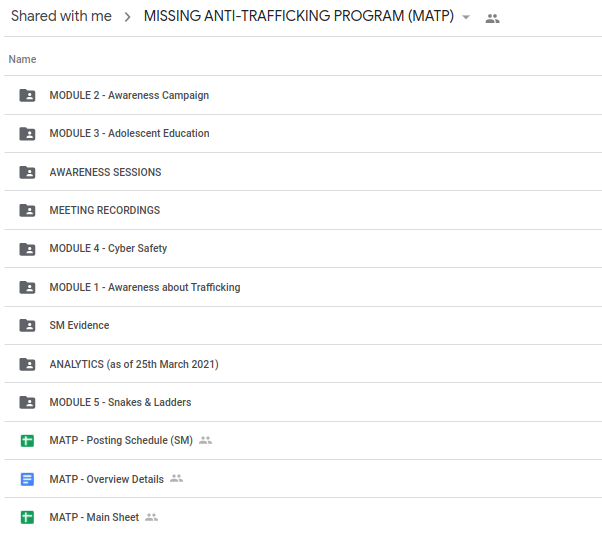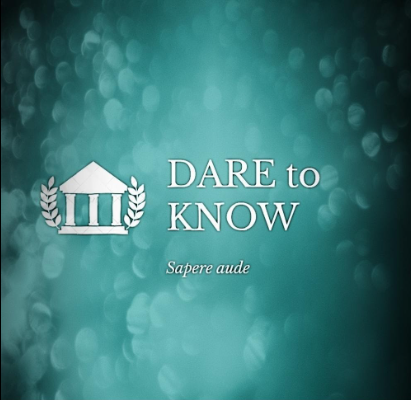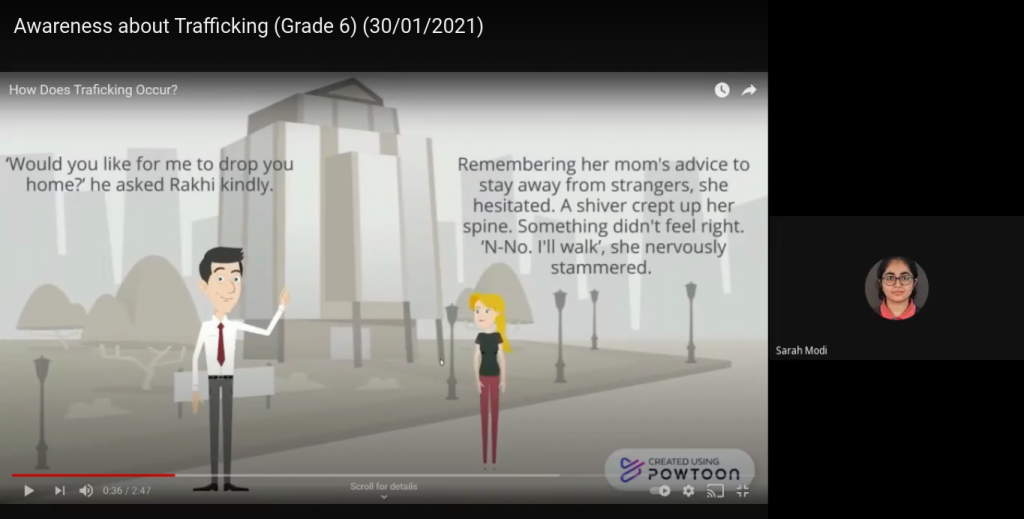MISSING is a public awareness campaign that aims to spread awareness about the plight of millions of girls worldwide who are trafficked for sexual exploitation. I, along with four others, collaborated with Missing Link Trust to participate in their six-month program which entailed five engaging, intricate and thorough modules.

Main sheet containing designated roles, module details, other planning: https://docs.google.com/spreadsheets/d/1-fAirRUnj72_GdG4yffPJ5cpjvQ8PjJDj3BfmqW_zIU/edit#gid=2101406812 
Common folder containing all evidences

Learning Outcome: 1
I found that I was able to share vital suggestions and contribute to group discussions while also being able to work effectively by myself. During the module one, I was incharge of making notes from our trafficking awareness sessions and online research. These notes turned out to be an immensely helpful resource and were heavily relied on while making our YouTube video scripts and awareness sessions. During modules three and four, I was the ‘Head Video Creator’. I was able to collaborate with the ‘Assistant Video Creator’ to make engaging, well-designed and impactful videos. My knowledge of the YouTube algorithm allowed me focus on normally overlooked aspects like thumbnails and video titles. These strengths – Balanced collaboration, time-management, good research skills helped me navigate through this program successfully.
At times, I got upset if someone missed their deadline, inturn throwing off the entire group schedule. I realise now that instead of sending constant remindersin the common group chat, I should have conversed with them in person, discussed the issues that they might be facing and searched for a solution together. This has taught me lessons about effective leadership that I will use in future – to not critsize openly and to be more empathetic and helpful.
Learning Outcome: 2
The program was highly demanding, requiring upto four hours of commitment per week, for six months. Amidst the COVID-19 pandemic, we had to conduct virtual awareness sessions for students ranging from Grade six to eight. Discussing topics like trafficking, sexuality and gender with such a young audience proved to be difficult. These topics are not as talked about in society, so it was imperative that we generate an open-minded discussion where our audience feels safe to express their thoughts. However, with camera’s and mic’s off, we weren’t able to guage the general mood and reactions to modify the flow of our sessions, so it felt lengthy and tedious to both sides. Earlier, our priority was to pack the sessions with as much information as possible. However, we eventually learned to ask questions in a simpler language to stimulate discussion.
Learning Outcomes: 3, 4 & 5
The basic framework for this CAS experience was given by the MATP organization. However, we empoyed our own take on it. Since there were five members, we designated one leader for each module who would be responsible for taking updates ensuring progress as per the timeline. There were subdivisons of each module aswell where each of us was given fixed roles. Since the roles were clearly assigned and mutually agreed on, everyone knew what was expected from them. We had a common spreadsheet where all relevant information concerning our group was put in. After completing our tasks, we were required to ‘submit’ our work by uploading it there. We had a meeting every week, after school on Monday. This established a routine dialogue between us where we were able to update our progress with others, discuss the weekly plan of action and debate ideas.
The video making part was quite challenging to me, especially with one video per week. The script writers would send me their script by a fixed date. The assistant video creator would copy-paste each dialogue to a slide on the video editing software and add the title. I would then select the background and the font, alignment and size of text. For the animation part, I used Canva due to its feature that allows customization of characters and their emotions. This process was quite time consuming as each slide required different characters and them doing different actions. This was followed by music selection, checking the time per slide and final review before uploading on YouTube (on a fixed date aswell). I encountered a few problems when a specific emotion or object was not available. I later learned to be more resourceful and creative with the existing features. We successfully uploaded upto twenty animated videos on our YouTube channel and multiple posters on our instagram account (linked above).
Making videos and posters was challenging by itself but promoting it to get viewership seemed almost impossible. Each of us started with reaching out to our family and friends, convincing them to subscibe to our accounts and share it with their friends. This exposed me to the challenges of making my content stand out and appeal to the algorithm amidst so much other content.
We had created a well oiled machine, with each member being a part of the assembly line. However, this also meant that one person deviating from the deadline would affect all of us. Here, our constant communication came in clutch, allowing us to remind each other to stay on track.
Learning Outcomes: 6 & 7
Human trafficking is a global issue. One which is not talked about or consdered taboo, particularly because of how heinous the crime is. I myself used to shudder at the thought of such harsh realities and pretend they don’t exist as I felt safe in my ignorance. After enrolling in this programme, I soon realised that it is unethical to avoid the dark reality of this world, and it is unethical to do nothing about it given the scope of positive impact that my actions can have. It has affected millions of families and turned innocent children into prostitutes, drug mules, slaves, and even corpses because they were either killed, died of exhaustion and injuries, or used for organ donations. In the sessions with the MISSING team I got to know how traffickers select their victims and explored real life based case studies. I recieved safety tips for both the online and offline world. Additionally, I got the platform to spread this information, to hopefully alert children and to sensitize them. The lack of dialogue about the trafficking racket is what helps it stay hidden. By conversing about it with so many people, we started a chain of awareness.
We were explicit and provided deep information in the content for social media, which was about trafficking and sexuality. This is because social media sites are age regulated and censorship of the clear truth was not required there. However, during the live sessions, we took care to use euphemisms like “bad touch” in place of sexual assault in order to not scare the children. However, we did talk about prostitution and what happens to trafficked children, girls especially, in order to protect them and prepare them to the best of our abilities.
Learner Profiles:
Knowledgeable: I gained immense knowledge about an issue I was previously ignorant about and I used that knowledge to educate others and spread awareness.
Communicator: I effectively communicated with members of my group, teachers and supervisors both in person and online. I learned how to be clear and precise, to avoid using more words than necessary. To reiterate and emphasize the crux of my message and avoid excess details while conversing with my group members. I also communicated with people online via our social media content. I reflected on my own experience learning about trafficking and tried to incorporate that to better impact my target audience online.

